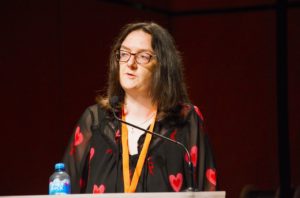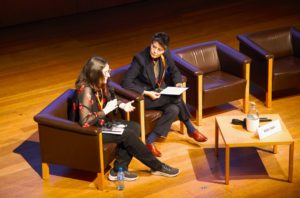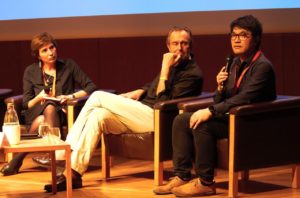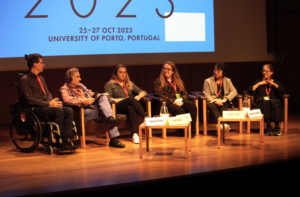2023 Porto, Portugal
ICAMT 49th ANNUAL CONFERENCE – October 25-27, 2023
 From October 25 to 27, 2023, the 49th ICAMT International Conference was held in Porto, Portugal, in the Auditorium of the Biblioteca Municipal Almeida Garret. Under the theme “Undoing Conflict in Museums: Materiality and Meaning of Museum Architecture and Exhibition Design”, this event -organized in collaboration between the Transdisciplinary Research Centre “Culture, Space, and Memory” (CITCEM), the Centre for Architectural and Urban Studies (CEAU), and the ICAMT Board -successfully brought together over 100 participants.
From October 25 to 27, 2023, the 49th ICAMT International Conference was held in Porto, Portugal, in the Auditorium of the Biblioteca Municipal Almeida Garret. Under the theme “Undoing Conflict in Museums: Materiality and Meaning of Museum Architecture and Exhibition Design”, this event -organized in collaboration between the Transdisciplinary Research Centre “Culture, Space, and Memory” (CITCEM), the Centre for Architectural and Urban Studies (CEAU), and the ICAMT Board -successfully brought together over 100 participants.
The conference featured three keynote speakers and twelve panelists who contributed valuable insights from their research and professional experiences, aligning with the four main themes outlined in the conference program. Complementing these discussions, each day included visits to case studies, fostering knowledge exchange and keeping participants abreast of the latest developments in museum projects in the Porto area.
KEY-NOTE SPEAKERS

 Karen Logan serves as the Senior Curator of History, overseeing the History, Archaeology, and World Cultures collections at both the Ulster Museum and the Ulster Transport Museum. In her presentation, she delved into the intricacies of curating the permanent exhibition titled “The Troubles and Beyond,” which addresses the historical narrative of Northern Ireland from the late 1960s to the present day, marked by civil and political conflicts. During her talk and subsequent discussions, the emphasis was placed on the collaborative process involved in developing this exhibition and how feedback and critiques from the public were incorporated after the opening of the show. The further discussions also highlighted the social significance of the exhibition for contemporary generations, shedding light on its role in fostering understanding and dialogue in the context of the region’s complex history.
Karen Logan serves as the Senior Curator of History, overseeing the History, Archaeology, and World Cultures collections at both the Ulster Museum and the Ulster Transport Museum. In her presentation, she delved into the intricacies of curating the permanent exhibition titled “The Troubles and Beyond,” which addresses the historical narrative of Northern Ireland from the late 1960s to the present day, marked by civil and political conflicts. During her talk and subsequent discussions, the emphasis was placed on the collaborative process involved in developing this exhibition and how feedback and critiques from the public were incorporated after the opening of the show. The further discussions also highlighted the social significance of the exhibition for contemporary generations, shedding light on its role in fostering understanding and dialogue in the context of the region’s complex history.

 Jean François Milou trained in Paris at l’École des Beaux Arts, and founded studio Milou Architecture, a practice specializing in adaptive reuse projects, based in Paris, Singapore, and Vietnam. Together with his associate Trung Thanh Nguyen, he presented two recent museum projects in Southeast Asia: The National Gallery in Singapore and the Danang City Museum in Vietnam. Both projects carried out by his studio were conceived with the use of local materials and with a sense of appreciation for local culture, since both sites of the projects occupy places that were once colonized and are witnesses to war.
Jean François Milou trained in Paris at l’École des Beaux Arts, and founded studio Milou Architecture, a practice specializing in adaptive reuse projects, based in Paris, Singapore, and Vietnam. Together with his associate Trung Thanh Nguyen, he presented two recent museum projects in Southeast Asia: The National Gallery in Singapore and the Danang City Museum in Vietnam. Both projects carried out by his studio were conceived with the use of local materials and with a sense of appreciation for local culture, since both sites of the projects occupy places that were once colonized and are witnesses to war.

 Nuno Grande, an architect, critic, curator, and associate professor at the University of Coimbra (DARQ/UC), has conducted thorough analyses of persistent conflicts within museums. His focus extends to the tensions between the architectural container and its content, as well as the intricate dynamics between cultural policies and the practices of art and architecture. Grande’s presentation encompassed a diverse range of cases throughout history, examining internationally renowned museums such as the Museum of Modern Art (MoMA), among others. His work sheds light on the complex interplay between form and function, policy and practice, providing valuable insights into the challenges faced by cultural institutions on a global scale.
Nuno Grande, an architect, critic, curator, and associate professor at the University of Coimbra (DARQ/UC), has conducted thorough analyses of persistent conflicts within museums. His focus extends to the tensions between the architectural container and its content, as well as the intricate dynamics between cultural policies and the practices of art and architecture. Grande’s presentation encompassed a diverse range of cases throughout history, examining internationally renowned museums such as the Museum of Modern Art (MoMA), among others. His work sheds light on the complex interplay between form and function, policy and practice, providing valuable insights into the challenges faced by cultural institutions on a global scale.
KEY THEME PRESENTATIONS
Key theme #1 – Dealing with Conflict revolved around addressing the impact of “invisible” systems within museums, exploring how these systems can generate and contribute to conflict zones, and proposing strategies for managing them. The presentations covered a diverse array of topics, spanning from considerations of the circular economy in museums to challenges related to lighting, conservation, and logistics of old and new buildings. Additionally, the discussions delved into the intricate process of creating artifacts for exhibitions, particularly within communities situated in conflict zones as example in Israel. This broad spectrum of subjects reflected a comprehensive exploration of the multifaceted issues arising from the often unseen but influential aspects of museum operations, providing a nuanced understanding of how these factors can contribute to or mitigate conflicts.
Key theme #2 – Symbols of Conflict was dual-pronged, emphasizing exhibitions and architecture as symbolic expressions of conflict. The first strand delved into challenging heritage exhibitions, featuring case studies involving sensitive subjects like displays of human remains. It also explored the intricate process of crafting exhibition designs that align with curatorial intentions, emphasizing content research and investigating strategies to effectively communicate controversial issues.
The second strand addressed the role of museum architecture in symbolizing and concealing conflicts. This included discussions on architectural extensions projects conducted underground, as well as the adaptive reuse of complex buildings transformed into contemporary art museums. The focus here was on how architectural decisions could contribute to concealing or revealing the historical and cultural conflicts inherent in a space, showcasing the transformative power of architecture in shaping narratives and perceptions within a museum context.
Key theme #3 – Processes and Conflict centered on the conflicts arising during the development of exhibition projects within specific geographical areas, with a particular emphasis on the influence of politics and the theme of colonialism. The discussions featured two case studies, one focused on Albania and the other on China. These case studies delved into the nuanced challenges faced in the process of conceiving and executing exhibitions narratives, highlighting the impact of political dynamics and historical themes.
Key theme #4 – Healing, Resistance, and the Future explored the influential role of museums in fulfilling their social mission by addressing conflicts, illustrated through two case studies. The first case study emphasized the significance of museum architecture in a specific project, underscoring how the design and structure play a crucial role in fulfilling the institution’s broader social objectives. The second case study focused on exhibition design, highlighting the negotiation of curatorial development and the active participation of a local community. Both cases shed light on how museums navigate and contribute to the resolution of conflicts, emphasizing the dynamic interplay between architecture, exhibition design, and community engagement in achieving their social mission.

CASE STUDIES
During the three days of the conference, participants had the opportunity to visit different case studies, providing a comprehensive exploration of various aspects related to museums. The sites included the Galeria da Biodiversidade-Centro Ciência Viva, Museu de História Natural e da Ciência da Universidade do Porto, Museu Nacional Soares dos Reis, Ateliê António Carneiro – Museu do Porto, Museu de Serralves, Reservatório – Museu do Porto, Casa da Arquitectura, Museu da Memória de Matosinhos, Casa do Design – Porto Design Biennale 2023, and Exploratório esad—idea.

The visits encompassed a range of considerations, including architectural features, exhibition design, technical and curatorial aspects, and the unique characteristics of each collection (art, architecture, design, sciences). Additionally, the importance of museum communication in the context of contemporary social media was highlighted and discussed. Beyond these aspects, the visits served as an invaluable opportunity to extend the dialogue initiated during the conference, fostering the exchange of ideas and experiences among museum professionals, and facilitating networking within the field.

Short Video Recaps from 3 days of the Conference:
